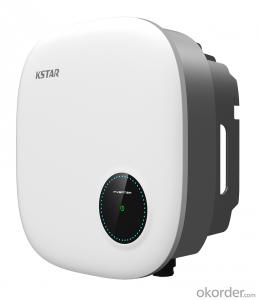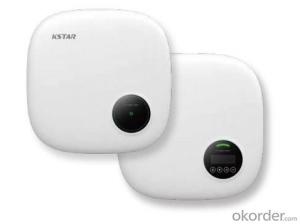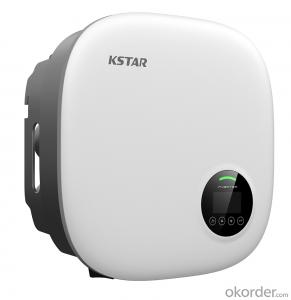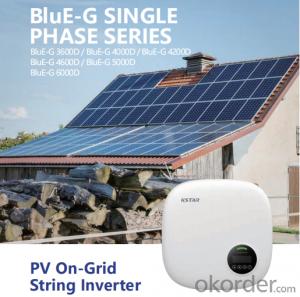String Grid-Tied PV Inverter BluE-G 3000D / 3600D / 4000D / 4200D / 4600D / 5000D / 6000D
- Loading Port:
- China main port
- Payment Terms:
- TT OR LC
- Min Order Qty:
- 50 pc
- Supply Capability:
- 15000 pc/month
- Option:
- 3KW-6KW
OKorder Service Pledge
OKorder Financial Service
You Might Also Like
Item specifice
KSTAR BluE Power Your Green Life
Product Description:
★Max. PV voltage up to 600V DC/AC ratio up to 1.5
★Type II DC SPD/Type III AC SPD IP65 protection
★High efficiency up to 98.3% Smaller and lighter
★Compatible for big capacity PV panel WiFi / 4G Plug optional
One Stop Solution Compatible with any type of Demand
Our BluE series covers single phase 1 to 6kw, three phase 3-25kw and up to 20kwh Energy Storage System. This range is predominantly designed for modern house and small commericial energy demands.
One App to monitor your power flow for different systems;
One Call for pre-sales training & after-sales service;
Technical Specifications:
| MODEL | BluE-G 3000D | BluE-G 3600D | BluE-G 4000D | BluE-G 4200D | BluE-G 4600D | BluE-G 5000D | BluE-G 6000D |
| Input(DC) | |||||||
| Max. DC Voltage | 600Vdc | 600Vdc | 600Vdc | 600Vdc | 600Vdc | 600Vdc | 600Vdc |
| Nominal Voltage | 380Vdc | 380Vdc | 380Vdc | 380Vdc | 380Vdc | 380Vdc | 380Vdc |
| Start Voltage | 100V | 100V | 100V | 100V | 100V | 100V | 100V |
| MPPT Voltage Range | 80V-560V | 80V-560V | 80V-560V | 80V-560V | 80V-560V | 80V-560V | 80V-560V |
| Number of MPP Tracker | 2 | 2 | 2 | 2 | 2 | 2 | 2 |
| Strings Per MPP Tracker | 1 | 1 | 1 | 1 | 1 | 1 | 1 |
| Max. Input Current Per MPPT | 15A | 15A | 15A | 15A | 15A | 15A | 15A |
| Max. short-circuit Current Per MPPT | 18A | 18A | 18A | 18A | 18A | 18A | 18A |
| Output(AC) | |||||||
| Nominal AC Output Power | 3000W | 3600W | 4000W | 4200W | 4600W | 4600W | 4600W |
| Max. AC Apparent Power | 3000VA | 3960VA | 4400VA | 4620VA | 5060VA | 5500VA | 6000VA |
| Nominal AC Voltage | 230V L-N | 230V L-N | 230V L-N | 230V L-N | 230V L-N | 230V L-N | 230V L-N |
| AC Grid Frequency Range | 50Hz / 60Hz±5Hz | 50Hz / 60Hz±5Hz | 50Hz / 60Hz±5Hz | 50Hz / 60Hz±5Hz | 50Hz / 60Hz±5Hz | 50Hz / 60Hz±5Hz | 50Hz / 60Hz±5Hz |
| Max. Output Current | 14.4A | 17A | 19A | 20A | 22A | 24A | 26A |
| Power Factor (cosφ) | 0.8 leading to 0.8 lagging | ||||||
| THDi | <3%< td=""> | ||||||
| Efficiency | |||||||
| Max. Efficiency | 98.10% | 98.10% | 98.30% | 98.30% | 98.30% | 98.30% | 98.30% |
| Euro Efficiency | 97.70% | 97.70% | 97.90% | 97.90% | 97.90% | 97.90% | 97.90% |
| Protection devices | |||||||
| DC switch | Yes | Yes | Yes | Yes | Yes | Yes | Yes |
| Anti-islanding Protection | Yes | Yes | Yes | Yes | Yes | Yes | Yes |
| Output Over Current | Yes | Yes | Yes | Yes | Yes | Yes | Yes |
| DC Reverse Polarity Protection | Yes | Yes | Yes | Yes | Yes | Yes | Yes |
| String Fault Detection | Yes | Yes | Yes | Yes | Yes | Yes | Yes |
| Surge Protection | DC Type III;AC Type III | ||||||
| Insulation Detection | Yes | Yes | Yes | Yes | Yes | Yes | Yes |
| AC Short Circuit Protection | Yes | Yes | Yes | Yes | Yes | Yes | Yes |
| General Specifications | |||||||
| Dimensions W x H x D | 380*380*150mm | ||||||
| Weight | 10kg | 10kg | 11kg | 11kg | 11kg | 11kg | 11kg |
| Operating Temperature Range | –25℃~+60℃ | ||||||
| Cooling Type | Natural | ||||||
| Max. Operation Altitude | ≤4000m | ||||||
| Max. Operation Humidity | 0-100% | ||||||
| AC Output Terminal Type | Quick Connector | ||||||
| IP Class | IP65 | ||||||
| Topology | Transformer-less | ||||||
| Communication Interface | RS485/WIFI/4G | ||||||
| Display | LCD | ||||||
| Certification & Standard | EN/IEC62109-1/2;IEC/EN61000-6-2;IEC/EN61000-6-4;IEC61683;IEC60068;IEC60529;IEC62116; IEC61727;EN50549-1;AS 4777.2;NRS 097;VDE-AR-N-4105;VDE 0126-1-1;CEI0-21;G98;G99;C10/C11;TED749; UNE217001;UNE217002;NB/T32004-2018;GB/T19964-2012;INMETRO | ||||||
Q:How the output voltage of the PV inverter and the grid-connected voltage are determined
Inverter is the DC power (battery, battery) into alternating current (usually 220V, 50Hz sine wave). It consists of inverter bridge, control logic and filter circuit. Widely used in air conditioning, home theater, electric wheel, power tools, sewing machines, DVD, VCD, computer, TV, washing machine, range hood, refrigerator, video recorders, massage, fan, lighting and so on. In foreign countries
Q:Installation and maintenance of photovoltaic grid - connected inverter
only when the local power sector permission by the professional and technical personnel to complete all the electrical connection before the inverter can be connected.
Q:What is the difference between a PV grid-connected inverter and an off-grid inverter?
Off-grid inverter is equivalent to their own to establish an independent small power grid, mainly to control their own voltage, is a voltage source.
Q:After the PV inverter, how to achieve the same period before the network?
Solar panel simulator: with MPPT function, simulated morning, noon, afternoon, evening, rainy weather, solar panels produced under different conditions in different voltages.
Q:Is the PV inverter a current source or a voltage source?
According to the waveform modulation method can be divided into square wave inverter, stepped wave inverter, sine wave inverter and modular three-phase inverter.
Q:Photovoltaic grid-connected inverter without DC emc how will happen
Solar photovoltaic power generation technology is the use of solar cells, the photovoltaic effect of semiconductor materials, solar radiation can be directly converted into a new type of power generation system, solar energy is a radiant energy, solar power means --- to direct conversion of sunlight Into electricity,
Q:What is the difference between low voltage grid connection and medium voltage grid connection?
For photovoltaic power plants when the power system accidents or disturbances caused by photovoltaic power plant grid voltage drop, in a certain voltage drop range and time interval, the photovoltaic power plant can ensure that non-off-line continuous operation.
Q:Is the grid side of the grid and the inverter?
The grid load side of the grid is the grid. The inverter is an important part of the PV grid-connected system and can not be regarded as an external load. Photovoltaic power generation system is included in both grid and off-grid.
Q:PV grid-connected inverter and independent inverter in the control of what is the difference
The independent inverter in the output voltage phase amplitude of the frequency control is initially set good. Independent inverter, you should refer to off-grid inverter, do not need to consider the grid situation.
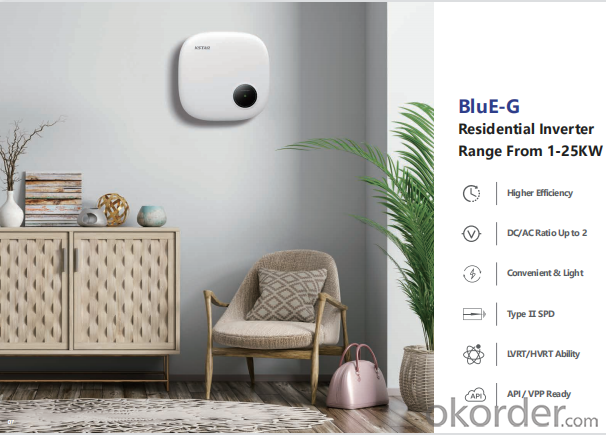

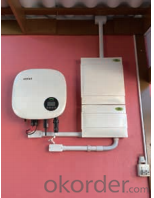
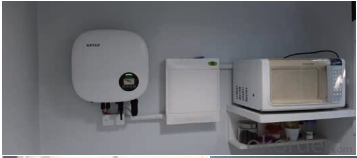

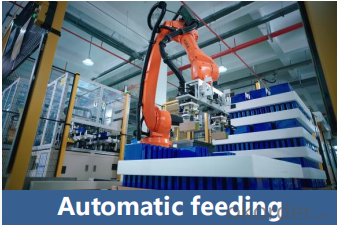
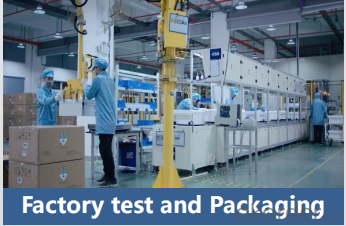
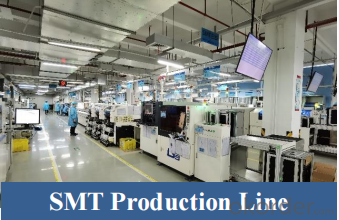
- Q:What is the lifespan of a solar inverter?
- The lifespan of a solar inverter typically ranges from 10 to 20 years, depending on various factors such as the quality of the inverter, usage patterns, maintenance, and environmental conditions.
- Q:How does a solar inverter affect the overall efficiency of a solar system?
- A solar inverter plays a crucial role in the overall efficiency of a solar system. It converts the direct current (DC) electricity generated by solar panels into alternating current (AC) electricity that can be used to power household appliances and feed into the grid. By efficiently converting and optimizing the electricity output, a solar inverter ensures minimal power losses and maximizes the system's overall efficiency.
- Q:What are the common issues and troubleshooting steps for a solar inverter?
- Some common issues with solar inverters include no power output, low power output, display or communication errors, and overheating. Troubleshooting steps for these issues may involve checking the input voltage and connections, inspecting the DC and AC cables for damage, resetting the inverter, updating firmware or software, ensuring proper ventilation and cooling, and contacting technical support if necessary.
- Q:What are the safety certifications to look for in a solar inverter?
- Some safety certifications to look for in a solar inverter include UL 1741, IEC 62109, and CSA C22.2 No. 107.1. These certifications ensure that the inverter meets specific safety standards, such as protection against electrical shocks, fire hazards, and grid disturbances. It is essential to check for these certifications to ensure the safe and reliable operation of the solar inverter.
- Q:How does the input power rating affect the performance of a solar inverter?
- The input power rating directly affects the performance of a solar inverter. A higher input power rating allows the inverter to handle larger amounts of power generated by the solar panels. This means that a higher input power rating can lead to better efficiency and performance of the solar inverter, as it can convert a greater amount of solar energy into usable electricity. Conversely, a lower input power rating may limit the inverter's capacity to handle high power outputs, potentially resulting in reduced efficiency and performance.
- Q:Can a solar inverter be used with both AC and DC power sources?
- No, a solar inverter is designed to convert DC power from solar panels into AC power for use in standard electrical systems. It cannot be used with both AC and DC power sources simultaneously.
- Q:How does a solar inverter protect against overvoltage and overcurrent?
- A solar inverter protects against overvoltage by continuously monitoring the voltage level of the solar panels. If the voltage exceeds a safe threshold, the inverter automatically limits the power output or shuts down temporarily to prevent damage to the system. Similarly, to protect against overcurrent, the inverter monitors the current flowing through the system. If the current exceeds a safe limit, the inverter adjusts the output power or shuts down to avoid overheating and potential electrical hazards.
- Q:Are there any government incentives for installing a solar inverter?
- Yes, there are government incentives for installing a solar inverter. Many countries offer financial incentives such as tax credits, grants, or rebates to encourage the adoption of renewable energy technologies like solar inverters. Additionally, some regions may have specific programs or initiatives that provide additional support or incentives for solar inverter installations. It is advisable to research and consult with local authorities or renewable energy organizations to determine the specific incentives available in your area.
- Q:What are the key differences between a central inverter and a string inverter?
- The key differences between a central inverter and a string inverter lie in their design and functionality. A central inverter is a large, centralized unit that converts the DC electricity generated by a solar array into AC electricity. It is typically installed in a central location, such as a utility room, and is responsible for converting the power from multiple strings of panels simultaneously. On the other hand, a string inverter is a smaller unit that is installed close to the solar panels and converts the DC power from each individual string into AC power. One major difference is the level of scalability. Central inverters are typically used in larger solar installations, such as commercial or utility-scale projects, where a large number of panels are connected in parallel. They can handle high power capacities and are highly efficient. In contrast, string inverters are commonly used in smaller residential or small-scale commercial installations, where a smaller number of panels are connected in series. They offer flexibility in system design and can be easily expanded or modified. Another difference is the impact of shading or module mismatch. In a string inverter system, if one panel in a string is shaded or experiences reduced performance, it can affect the overall output of the entire string. This is because all panels in a string are connected in series, and the output is limited by the weakest performing panel. In a central inverter system, however, the impact of shading or module mismatch is minimized as each string operates independently, allowing for better performance optimization. Additionally, maintenance and monitoring differ between the two types. Central inverters are easier to access and maintain as they are typically installed in a dedicated location. They also offer advanced monitoring capabilities, allowing for centralized tracking of system performance. String inverters, being installed close to the panels, require more individual maintenance and monitoring efforts. Both central and string inverters have their own advantages and disadvantages, and the choice between them depends on factors such as project size, system design, shading conditions, and budget.
- Q:What is the role of an isolation transformer in a solar inverter?
- The role of an isolation transformer in a solar inverter is to provide electrical isolation between the solar panels and the grid. It helps protect the solar panels and the inverter from electrical disturbances, such as voltage spikes or surges, that may occur in the grid. Additionally, the isolation transformer helps mitigate ground fault currents and provides a safety barrier between the grid and the solar system.
1. Manufacturer Overview |
|
|---|---|
| Location | |
| Year Established | |
| Annual Output Value | |
| Main Markets | |
| Company Certifications | |
2. Manufacturer Certificates |
|
|---|---|
| a) Certification Name | |
| Range | |
| Reference | |
| Validity Period | |
3. Manufacturer Capability |
|
|---|---|
| a)Trade Capacity | |
| Nearest Port | |
| Export Percentage | |
| No.of Employees in Trade Department | |
| Language Spoken: | |
| b)Factory Information | |
| Factory Size: | |
| No. of Production Lines | |
| Contract Manufacturing | |
| Product Price Range | |
Send your message to us
String Grid-Tied PV Inverter BluE-G 3000D / 3600D / 4000D / 4200D / 4600D / 5000D / 6000D
- Loading Port:
- China main port
- Payment Terms:
- TT OR LC
- Min Order Qty:
- 50 pc
- Supply Capability:
- 15000 pc/month
- Option:
- 3KW-6KW
OKorder Service Pledge
OKorder Financial Service
Similar products
New products
Hot products
Related keywords
